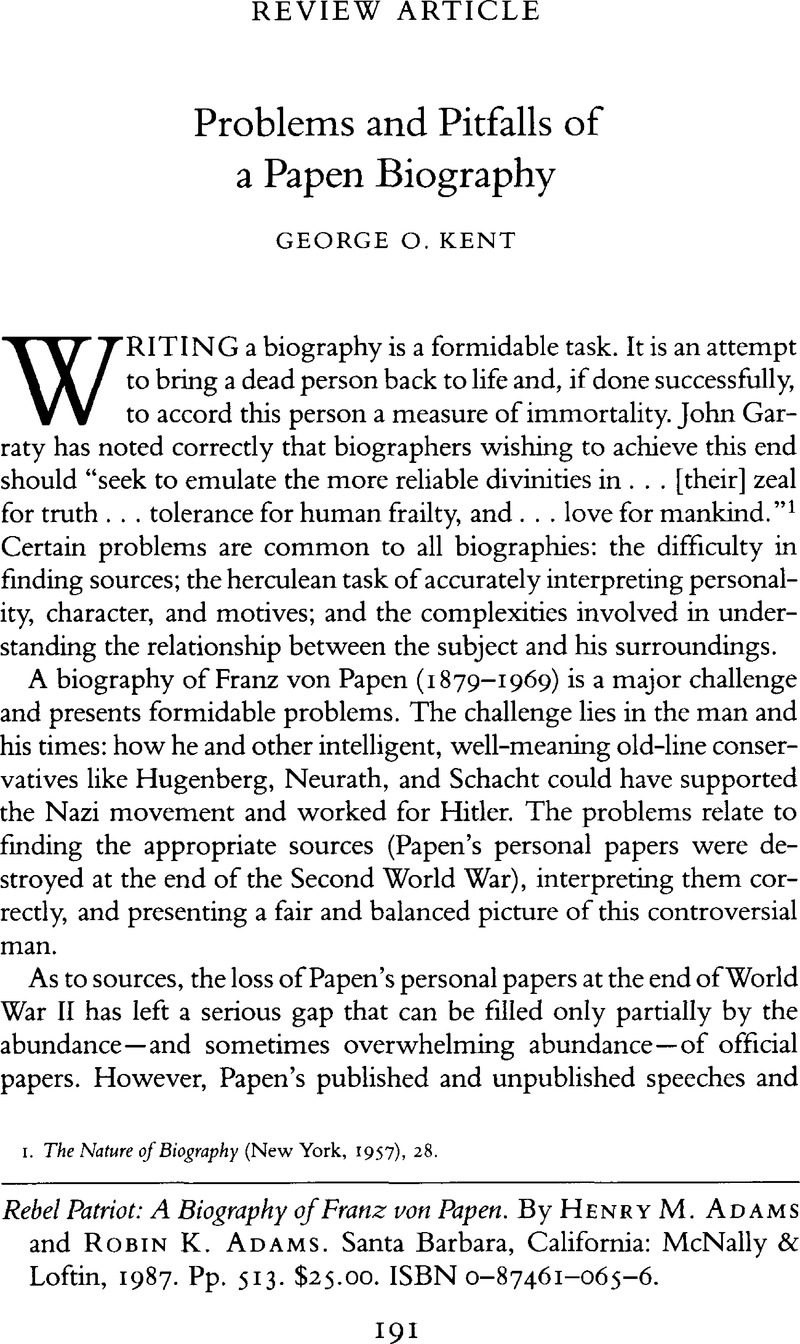Article contents
Problems and Pitfalls of a Papen Biography
Published online by Cambridge University Press: 16 December 2008
Abstract

- Type
- Review-Article
- Information
- Copyright
- Copyright © Conference Group for Central European History of the American Historical Association 1987
References
1. The Nature of Biography (New York, 1957), 28.Google Scholar
2. That it is, for all practical purposes, an official biography, is clear from the Preface: “… the writer request[ed] permission to write a biography of Franz von Papen …” and Papen gave his permission.
3. The exception is West, Nigel, British Security Operations (New York, 1982)Google Scholar. The failure of the authors to consult the more recent secondary literature can be seen in the case of Papen's activities in Austria, where the authors rely on Eichstädt, U., Von Dollfuss zu Hitler, which was published in 1955Google Scholar.
4. For the pertinent passages of the State Supreme Court decision of 25 October 1932, see Benz, W. and Geiss, I., Staatsstreich Gegen Preussen (Düsseldorf, 1982), doc. no. 9, pp. 65–66Google Scholar. This study and Biewer, L., “Der Preussenschlag vom 20. Juli 1932,” in Blätter für deutsche Landesge-schichte 119 (1983): 159–72Google Scholar, present a more balanced account of these events and refer to the extensive literature on this subject. Further, the authors' system of references is confusing. There are no references for 28 pages of this chapter; instead, there is a general reference at the beginning to unspecified material in the Reich Chancellery, Foreign Ministry, and other governmental files, which leaves the reader to determine the origins of various statements and assertions. How, for example, is a reader to find the source of the statement “… that Friedrich Stampfer, the editor-in-chief of… the… Vorwärts… conducted serious negotiations with the Soviet ambassador in Berlin” (152), when thousands of microfilm frames and hundreds of pages of documents would have to be examined to do so? The authors' research is consistently based on a narrow selection of government documents, on Papen's memoirs, and on the secondary literature of the 1950s and 1960s. Neither the Bracht Nachlass in the Zentralarchiv in Potsdam, the Severing Papers in the SPD archives in Bonn, nor the extensive secondary literature of the 1970s or 1980s has been used or is even mentioned.
5. These are Goerlitz, W., Hindenburg (Bonn, 1953)Google Scholar, Dorpalen, A., Hindenburg and the Weimar Republic (Princeton, 1964)CrossRefGoogle Scholar, Vogelsang, T., Reichswehr, Staat und NSDAP (Stuttgart, 1962)Google Scholar, and Meissner, H. O. and Wilde, H., Die Machtergreifung (Stuttgart, 1958)Google Scholar. They are apparently unaware of recent scholarship, particularly that of Turner, H. A. Jr., German Big Business and the Rise of Hitler (New York, 1985)Google Scholar and Muth, H., “Das Kölner Gespräch am 4. Januar 1933,” in Geschichte in Wissenschaft und Unterricht 37 (1986), nos. 8 and 9.Google Scholar
6. There are two references. The first part is based on Bracher, K. D., Auflösung der Weimarer Republik (Stuttgart, 1957), 715–17Google Scholar; Vogelsang, Reichswehr, 374–80; Dorpalen, Hindenburg, 427, 430–31. The second part is based on the decision of the Court of Appeals in 1949.
7. Although what the authors mean by “muddy sources” and the “entire complex of the years 1933 to 1945,” is unclear, it is worth noting that the authors throughout their study carefully avoid any mention of the Einsatzgruppen, death camps, or crimes committed by the regime.
8. One glaring example is the authors' assertion that Papen's “two books, Der Wahrheit einer [sic] Gasse, and Vom Scheitem einer Demokratie, were systematically hushed up” (506). In view of the numerous reviews and discussions of both books in the West German press and periodical literature, it is difficult to fathom how this statement can be supported.
9. Stylistically, this is among the worst of the old-time diplomatic accounts. Many directives, reports, cabinet minutes, and letters are presented paragraph by paragraph, and sometimes line by line, including the most insignificant details. (See especially 150ff. and 182ff.)
- 1
- Cited by


